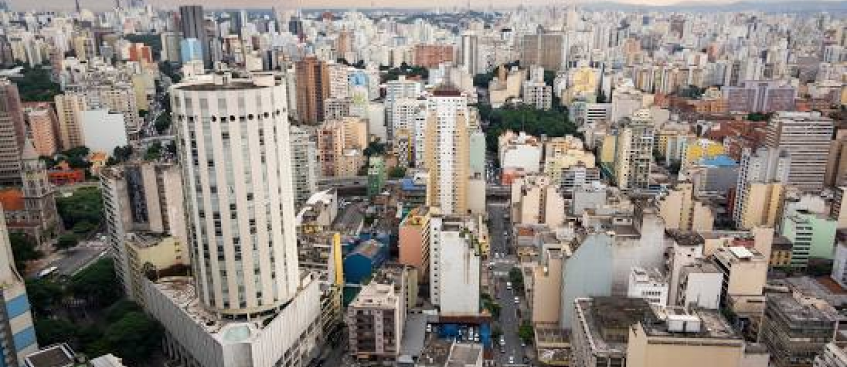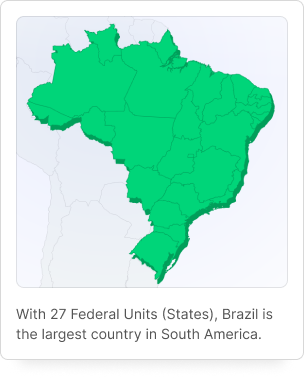Amapá
Amapá is a unique and promising state in the northern region of Brazil, offering a blend of natural wonders and economic potential. Here are some key aspects that make Amapá a notable region in Brazil:
- HDI: 0.688 - Medium
- Population: 733,759 (est)
- Total Area: 142,471 km2
- Roadways: 3,383km

Demographics
Covering an area of approximately 248,209 square kilometers, São Paulo is located in the southeastern region of Brazil, sharing borders with the states of Minas Gerais, Rio de Janeiro, Mato Grosso do Sul and Paraná. Its capital, São Paulo City, is the largest city in Brazil. The state is also the most populous in Brazil, with over 44 million people. Only São Paulo city concentrates more than 12 million residents.
- Largest cities
- Region
- Population
- São Paulo
- São Paulo
- 11,316,149
- Guarulhos
- Guarulhos
- 1,233,436
- Campinas
- Campinas
- 1,088,611
- São Bernardo do Campo
- São Paulo
- 770,253
Economy
São Paulo has a significant contribution to Brazil’s GDP, with its economy being one of the largest in South America. In 2022, São Paulo’s GDP was XXXX. The state is known for its strong financial and industrial base, which comprises the automotive industry, agribusiness, technology and innovation. DADOS INDÚSTRIA AUTOMOTIVA.

- Largest cities
- Region
- Population
- São Paulo
- São Paulo
- 11,316,149
- Guarulhos
- Guarulhos
- 1,233,436
- Campinas
- Campinas
- 1,088,611
- São Bernardo do Campo
- São Paulo
- 770,253
Industry
Regarding agribusiness, the state is a leading producer of agricultural products such as sugarcane, oranges, coffee, and soybeans, contributing significantly to Brazil's agribusiness sector – NÚMEROS 2022.
São Paulo has a growing technology sector, with a focus on software development, IT services, and startups. The city of Campinas, in particular, has a burgeoning tech ecosystem. Thus, there is also a thriving startup ecosystem, with numerous incubators, accelerators, and co-working spaces. The city of São Paulo is home to many tech startups focusing on areas like fintech, healthtech, and e-commerce.
Main activities
- Sugar cane production
- Automobile and aviation
- Oil and gas production
- Coffe bean production
- Orange growing
- Technology and software development
Education
The state boasts some of Brazil's most prestigious universities, including the University of São Paulo (USP), the University of Campinas (UNICAMP), and the São Paulo State University (UNESP). These institutions are recognized for their research and innovation contributions MAIS INFORMAÇÃO.
About Brazil
Brazil is a federation composed of 26 states, one federal district, and the 5,570 municipalities. Learn more about what each region can offer:
Brazil's diversified economy includes agriculture, industry, and a wide range of services.[259] The large service sector accounts for about 72.7% of total GDP, followed by the industrial sector (20.7%), while the agriculture sector is by far the smallest, making up 6.6% of total GDP.[260]

Regions

North Region
With seven states, the region is dominated by the Amazon Rainforest, the largest tropical rainforest in the world. The economy is influenced by agriculture, forestry and mining, with the sustainable management of natural resources at the center of public policies.

Northeast Region
The region presents a lengthy coastline along its nine states. Although agriculture has been a traditional economic driver, renewable energy, petrochemicals and innovation have seen a significant growth in recent years, changing the region's vocation.

Central-West Region
Only three states and a Federal District make it the agricultural heartland of Brazil. It is also home to a diverse array of wildlife and ecosystems, including parts of the Amazon rainforest and the Pantanal, the world's largest tropical wetland area. Brasília, the country's capital, is an important hub in the region.

Southeast Region
Marked by its dynamic urban centers, the region drives Brazil's innovation, commerce and industrialization. Comprising four states, it is home to the country's financial capital, São Paulo, which is also Latin America's economic center and one of the major global cities.

South Region
The region stands out as a well-developed portion of Brazil. It has a strong economic performance supported by a highly productive agriculture and a skilled industry, which reflects in the region's high standard of living, efficient infrastructure and economic stability.

